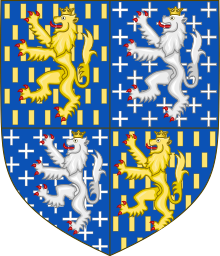From Wikipedia, the free encyclopedia
Count Philipp I of Nassau-Weilburg (1368 – 2 July 1429) was Count of Nassau in Weilburg, Count of Saarbrücken and Seigneur of Commercy Château bas in 1371–1429.
This article has multiple issues. Please help improve it or discuss these issues on the talk page. (Learn how and when to remove these messages)
|
Philipp I of Nassau-Weilburg | |
|---|---|
 | |
| Born | 1368 Weilburg |
| Died | 2 July 1429 Wiesbaden |
| Buried | Klarenthal Abbey |
| Noble family | House of Nassau |
| Spouse(s) | Anna of Hohenlohe-Weikersheim Elisabeth of Lorraine-Vaudémont |
| Father | John I of Nassau-Weilburg |
| Mother | Johanna of Saarbrücken |

Philipp was a son of John I, Count of Nassau-Weilburg (1309 – 1371) and Johanna, Countess of Saarbrücken (d. 1381), daughter of John II, Count of Saarbrücken (d. 1381).
Philipp inherited the County of Nassau-Weilburg from his father in 1371 and the County of Saarbrücken from his mother 1381. For the first ten years, his mother was the regent in his place, then bishop Friedrich of Blankenheim was the regent until his majority.
Philipp married twice and had several children, and his first wife Anna brought some territories in Trier that were added to his realm. At Philipps death in 1429, the counties were ruled jointly by his eldest sons, with their mother Elisabeth as regent until 1442, then it was divided between them, Philipp getting Nassau-Weilburg and Johann getting Saarbrücken and Commercy. At Philip's majority in 1438 he began ruling in collaboration with his mother, and provisions were made for her future.
In the war 1387–1389 (de) Philipp sided with the Bavarian duchies, against the Swabian union (de). For his achievements at the battle of Döffingen (de) he was honoured with the accolade. His involvement gave important allies and influence in southern Germany. In 1398 he was accredited with the privileges of coinage by Emperor Wenceslaus, and the power of his realm was consolidated. The emperor appointed him also to supervise the "landfrieden" in Rhine and Wetterau areas. In the national politics he both collaborated in the removal of emperor Wenceslaus 1400, protecting his successor Rupert and then joining many other lords in the opposition against him 1405–07, and until his Rupert's death in 1410. He participated at the crowning of the successor, Sigismund, Holy Roman Emperor, who elevated him, and made him a member of his council, and "Hauptmann" (leader) of the nobility in Luxembourg. He was also a member of the council of the French king.
At the Council of Constance, Philipp supported King Sigismund against the policies of certain Popes, at the time of the Western Schism.
Firstly, Philipp married in 1385 with Anna of Hohenlohe-Weikersheim (d. 11 October 1410), daughter of Count Kraft IV of Hohenlohe-Weikersheim (de) (d. 1399).[1] They had:
Secondly, he married in 1412 with Elisabeth of Lorraine-Vaudémont (c. 1395 – 1456), who bore:
One daughter may have been from either marriage, probably with Anna:
Also, he had at least three illegitimate children:
| Ancestors of Philipp I, Count of Nassau-Weilburg | ||||||||||||||||||||||||||||||||||||||||||||||||||||||||||||||||||||||||||||||||||||||||||||||||||||||||||||||||||||||||||||||||||||||||||||||||||||||||||||||||||||||||||||||||||||||||||||||||||||||||||||||||||||||||||||||||||||||||||||||||||||||||||||||||||||||||||||||||||||||||||||||||||||||||||||||||||||||||||||||||||||||||||||||||||||||||||||||||||||||||||||||||||||||||||||||||||||||||||||||||||||||||||||||||||||||||||||||||||||||||||||||||||||||||||||||||||||||||||||||||||||||||||||||||||||||||||||||||||||||||||||||||||||||||||||||||||||||||||||||||||||||||||||||||||||||||||||||||
|---|---|---|---|---|---|---|---|---|---|---|---|---|---|---|---|---|---|---|---|---|---|---|---|---|---|---|---|---|---|---|---|---|---|---|---|---|---|---|---|---|---|---|---|---|---|---|---|---|---|---|---|---|---|---|---|---|---|---|---|---|---|---|---|---|---|---|---|---|---|---|---|---|---|---|---|---|---|---|---|---|---|---|---|---|---|---|---|---|---|---|---|---|---|---|---|---|---|---|---|---|---|---|---|---|---|---|---|---|---|---|---|---|---|---|---|---|---|---|---|---|---|---|---|---|---|---|---|---|---|---|---|---|---|---|---|---|---|---|---|---|---|---|---|---|---|---|---|---|---|---|---|---|---|---|---|---|---|---|---|---|---|---|---|---|---|---|---|---|---|---|---|---|---|---|---|---|---|---|---|---|---|---|---|---|---|---|---|---|---|---|---|---|---|---|---|---|---|---|---|---|---|---|---|---|---|---|---|---|---|---|---|---|---|---|---|---|---|---|---|---|---|---|---|---|---|---|---|---|---|---|---|---|---|---|---|---|---|---|---|---|---|---|---|---|---|---|---|---|---|---|---|---|---|---|---|---|---|---|---|---|---|---|---|---|---|---|---|---|---|---|---|---|---|---|---|---|---|---|---|---|---|---|---|---|---|---|---|---|---|---|---|---|---|---|---|---|---|---|---|---|---|---|---|---|---|---|---|---|---|---|---|---|---|---|---|---|---|---|---|---|---|---|---|---|---|---|---|---|---|---|---|---|---|---|---|---|---|---|---|---|---|---|---|---|---|---|---|---|---|---|---|---|---|---|---|---|---|---|---|---|---|---|---|---|---|---|---|---|---|---|---|---|---|---|---|---|---|---|---|---|---|---|---|---|---|---|---|---|---|---|---|---|---|---|---|---|---|---|---|---|---|---|---|---|---|---|---|---|---|---|---|---|---|---|---|---|---|---|---|---|---|---|---|---|---|---|---|---|---|---|---|---|---|---|---|---|---|---|---|---|---|---|---|---|---|---|---|---|---|---|---|---|---|---|---|---|---|---|---|---|---|---|---|---|---|---|---|---|---|---|---|---|---|---|---|---|---|---|---|---|---|---|---|---|---|---|---|---|---|---|---|---|---|---|---|---|---|---|---|---|---|---|---|---|---|---|---|---|---|---|---|---|---|---|---|---|---|---|---|---|---|---|---|---|---|---|---|---|---|---|---|---|---|---|---|---|---|---|---|---|---|---|---|---|---|---|---|---|---|---|---|---|---|---|---|---|---|---|---|---|---|---|---|---|---|---|---|---|---|---|---|---|---|---|---|---|---|---|---|---|---|---|---|---|---|---|---|---|---|---|---|---|
| ||||||||||||||||||||||||||||||||||||||||||||||||||||||||||||||||||||||||||||||||||||||||||||||||||||||||||||||||||||||||||||||||||||||||||||||||||||||||||||||||||||||||||||||||||||||||||||||||||||||||||||||||||||||||||||||||||||||||||||||||||||||||||||||||||||||||||||||||||||||||||||||||||||||||||||||||||||||||||||||||||||||||||||||||||||||||||||||||||||||||||||||||||||||||||||||||||||||||||||||||||||||||||||||||||||||||||||||||||||||||||||||||||||||||||||||||||||||||||||||||||||||||||||||||||||||||||||||||||||||||||||||||||||||||||||||||||||||||||||||||||||||||||||||||||||||||||||||||
Seamless Wikipedia browsing. On steroids.